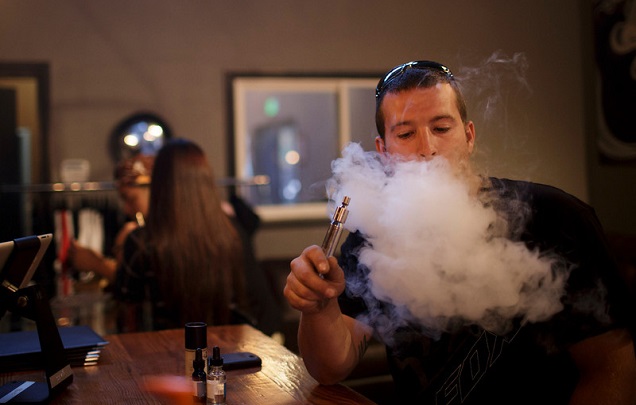
Second-hand vapor from e-cigarettes is one of the primary areas of concern regarding the technology, for understandable reasons. From an outsider’s perspective, a vaper looks like a polluter; pumping out a fog of chemicals that appears suspiciously similar to cigarette smoke. Of course, if you actually learn something about the ingredients of e-cigarettes (propylene glycol, glycerin, nicotine and food flavorings) or any of the research conducted thus far, then your level of concern will plummet dramatically. There doesn’t seem to be much to worry about at all, and this sentiment is echoed by the findings of a recent piece of research into the emissions from e-cigarettes which may be inhaled by bystanders.
However, the prevailing concern about the hypothetical dangers of e-cigarettes seems to have seeped into the researchers’ thinking on the issue, because they chose to conclude that “Overall, our data underline that e-cigarettes are not emission-free and impair indoor air quality. Exposure to e-cigarette pollutants might be a health concern,” despite finding precious little in the way of emitted harmful chemicals.
Summary
- Researchers used a café-sized, reasonably well ventilated room to test the emissions from three different e-liquids (each tested with and without nicotine) produced by three vapers per session, in comparison with background levels recorded on a previous day.
- All nicotine-free e-liquids contained no nicotine, but ones with nicotine were found to have 20 percent higher quantities than stated. Tobacco-specific nitrosamines weren’t detected in the e-liquids.
- There was no difference in carbon dioxide or carbon monoxide levels after vaping (compared to baseline level), nor in volatile organic compounds (apart from a small increase in formaldehyde in one session) and no increase in the concentration of most metals (aside from 2.4 times more aluminum).
- There was a 20 percent increase in the seven polycyclic aromatic hydrocarbons classed as carcinogens after vaping, but absolute concentrations were still very low.
- The findings suggest that vaping poses no threat to bystanders, but the researchers focused on the statement that “e-cigarettes are not emission-free” in the discussion section, despite it being painfully obvious to anybody that they aren’t emission free (vapor is exhaled by users, after all).
- In addition, puzzling differences between the detected quantities on vaping days compared to the control days (much less metals present during vaping, for instance), suggest that ordinary variations in quantities may undermine some of the findings.
What They Did – Measuring Components of Vapor in a Café-Like Setting

The researchers used a room from an office building for the study, which had three tables in to simulate (in an admittedly pointless fashion) a café-like setting. The room was moderately well-ventilated: over half of the indoor air was replaced with fresh air per hour, an air exchange rate of 0.56/hour. The experiment took place over seven days, with the first day – the “control” day – consisting of measurements taken in the room when no vaping was taking place, and on the remaining six days during 2-hour vaping sessions by three volunteers. They sat around one table, and two other tables were placed around a meter away with sampling equipment on them. The room was thoroughly aired out between tests to minimize the potential impact of contamination from previous testing periods. They specifically looked at quantities of propylene glycol, glycerin, nicotine, volatile organic compounds, polycyclic aromatic hydrocarbons, metals and carbonyls, as well as looking at the overall quantities of particles emitted and their concentration.
In addition to measuring the emissions from the vapers, the researchers sampled the quantities of carbon monoxide and nitric oxide on the vapers’ breath before and after each session, and took urine samples for the following 24 hours so they could check for the presence of metabolites (break-down products such as cotinine from nicotine).
Three different e-liquids were used in the experiment, with one nicotine-containing and one nicotine-free version of each being tested. They performed chemical analyses on the liquids too, looking primarily for contaminants such as tobacco-specific nitrosamines.
What They Found – Vaping Has Minimal Impact on Indoor Air Quality

The e-liquids mainly consisted of propylene glycol and glycerin, as expected, and the nicotine levels were on average 22 percent higher than the stated concentrations. However, none of the nicotine-free liquids contained nicotine. The researchers could detect nitrosamines at concentrations above 0.22 nanograms (billionths of a gram) per ml, but none were found in the liquids.
Since e-cigarette vapor is composed of particles, the researchers expectedly found notable increases in the amount of particulate matter when the volunteers were vaping in the room. There was no significant increase in carbon monoxide or carbon dioxide emission between the control and vaping days, and the main increase found across tests was in the concentrations of propylene glycol, glycerin and nicotine. Nicotine concentrations, however, only reached a maximum of 1.3 micrograms per cubic meter, which is a thousandth of a milligram (the unit the nicotine content of e-liquids is usually measured in). This illustrates that the levels of nicotine in the air in the vicinity of vapers increases, but not to significant levels. If a bystander were magically able to inhale all of the nicotine in the 45 cubic meter testing room, based on this estimate (which was the highest observed in the study), he or she would only have consumed 58.5 micrograms, or 0.0585 mg of nicotine. In other words, barely any.
For volatile organic compounds and aldehydes, there was no significant increase in comparison to the control day for benzene, acrolein, acetone and formaldehyde – with the exception of one session in which the quantity of formaldehyde increased from 25 (control) to 55 micrograms per cubic meter. Vanillin – a vanilla flavoring – and benzylalcohol – a common fragrant component of cosmetics – increased slightly during the vaping sessions, with no other notable changes.
There was a broad increase in polycyclic aromatic hydrocarbons, with between 30 and 90 percent greater concentrations in the room on the days with vaping. The absolute amounts were still very low, the total for all 16 measured increasing from around 0.35 micrograms (control) to a maximum of around 0.66 micrograms per cubic meter during vaping. Although on some occasions it was almost double the background level, we obviously breathe the background quantities all the time, so this is not a real cause for concern. For the seven classified as likely carcinogens, the concentration only increased an average of 20 percent against background levels.
For the metals, only aluminum showed an increase, rising to 2.4 times background levels during vaping. Metals notably increased by cigarette smoking showed no change from background levels after vaping, and on many of the vaping days the concentrations of metals were actually much lower than on the control day. For example, there was around 6.7 micrograms per cubic meter of iron on the control day, but on the vaping days it reached a maximum of around 3.8 micrograms per cubic meter. This isn’t to say that vaping somehow vacuums metals up from the surrounding air, but it clearly shows how the emissions from vaping are dwarfed by the ordinary variations in the levels of metallic elements in our air.
The tests on the vapers themselves revealed very little, showing significant increases in exhaled nitric oxide after vaping nicotine-containing liquids. These increases were less than five parts per billion (again, showing just how minor the differences are), but it’s generally considered a marker of airway inflammation. However, this has been detected in other research and is expected to be a transient effect related to mechanical irritation (an expected consequence of inhaling not-air, in other words).
The was no effect on the quantity of exhaled carbon monoxide from vaping, since e-cigs don’t contain or produce it; and urine analyses showed increases in nicotine and cotinine, as expected from nicotine consumption. There was an increase of a metabolite of acrolein in vapers’ urine, but other research has shown that this (and all other trace components) is only present in e-cig vapor in miniscule quantities not expected to pose a risk to users’ health, much less that of bystanders.
Conclusion – No Cause for Concern, Unless You Ask the Researchers
Overall, this study provides further evidence that any bans on vaping in public places are not based on science, but fear and irrationality. When you can legitimately compare emissions from e-cigarettes to those from human breath and ordinary outdoor air, you can rest assured that there’s nothing to worry about. But is that the message portrayed by the discussion section for this paper or its conclusion? Sadly, no.
Instead they filled the end of the paper with statements like, “Exposure to e-cigarette pollutants might be a health concern,” and “e-cigarettes and especially nicotine-containing liquids, as extremely toxic substances, should be officially regulated and labeled with appropriate warnings on health risks, particularly toxicity in children.” They did detect some, very minor quantities of potentially harmful chemicals, but with the concentrations of them rarely exceeding background levels, such concern doesn’t seem warranted based on this study. In addition, their comments regarding the “extremely toxic” nature of nicotine e-liquids were based on the idiotically low 60 mg figure for the toxic dose of nicotine, which has been seriously called into question by newer research.
And – as well as blowing the implications of the findings way out of proportion – they said nothing to address what seems to be a pretty notable issue with the study in the discussion. As noted earlier, the indoor metallic content of the air was actually much higher on the “control” day than on any of the vaping days, indicating a notable variation in ordinary levels which could have impacted the results. Perhaps sampling the “control” air at the same time as the experimental conditions in a similar but not vapor-filled room (the neighboring office room, for example) would have been a good idea. This issue clearly isn’t limited to metals, either: although the research confirmed that no nicotine was present in the nicotine-free liquids, the level detected in the room when the second nicotine-free liquid was tested was over twice as high as in the no-vaping measurement. What proportion of the changes observed are actually due to vaping is therefore not so clear.
However, this wasn’t much of a concern in the interpretation of the study. The comment “e-cigarettes are not emission free” was followed by a statement about the fact that nicotine, propylene glycol and glycerin (otherwise known as the declared ingredients) were present in the vapor. The conclusion doesn’t appear designed to convey the findings, instead, and as is depressingly common, it looks like the aim was to point an accusatory finger at e-cigarettes regardless of what the data says. They say there were no conflicts of interest to declare, but it’s hard to read the discussion section of the paper and conclude that it was written with scientific objectivity in mind.

